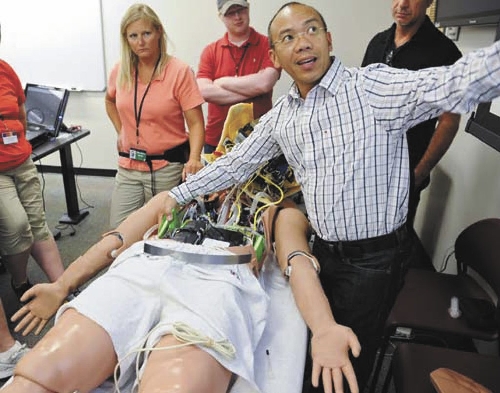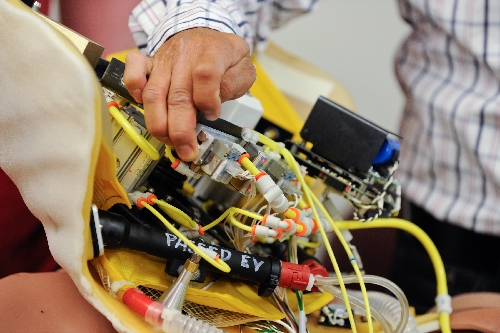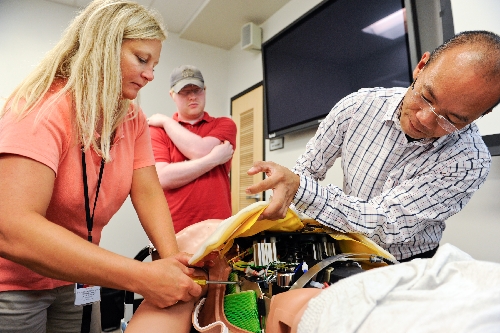Techs learn to provide TLC to ‘patients’
There was this guy at the front of a room Friday in UNLV's Clinical Simulation Center with his hands stuffed inside a wide-open rib cage.
"Now you see the chest cavity," he said, a dozen students looking on.
"That's all that?" said one of the students, pointing at a slide from a Powerpoint presentation on the big screen.
"Yeah," said the instructor, Jireh Providencia, with CAE Healthcare, "that's all that."
The slide on the screen was a Torso Pneumatic Diagram. It showed a schematic of the electronic guts of the guy on the table - the patient - a technological wonder that the term "medical mannequin" doesn't seem to adequately describe.
These things have a pulse. They breathe. They can dilate their pupils so they look like they've got something wrong with their brains. Some can even give birth.
Nursing students and others can intubate them. They can give them chest compressions, fix traumatic wounds, take their blood pressure, even listen to their complaints.
They are a relatively new technology, given the computing power available these days. They are used extensively at the Clinical Simulation Center, a joint operation between the schools of nursing at UNLV and Nevada State College and the University of Nevada School of Medicine.
"This allows us to let the students practice on mannequins instead of on patients," said Carolyn Yucha, dean of UNLV's school of nursing.
It's safer for the patients, and it allows students to be exposed to things they might not have encountered in their training otherwise.
"It lets us give students real-life experiences without putting any patients at risk," she said.
What she doesn't want, though, is her faculty members getting stuck tinkering with the technology when it's not working. There is a critical nursing faculty shortage right now. They have enough work to do.
"I don't need my faculty having to fix a mannequin when I can pay someone half as much to do it," she said.
Which is where Lance Baily, who used to be the center's director, comes in.
"We feel like we're doing something no one else in the world is doing," he said.
Baily left the center last year to start his own group, the Gathering of Healthcare Simulation Technology Specialists, GHOSTS.
He said most conventions that focused on the medical mannequins were geared toward the faculty, the doctors and nurses.
He started his group so the technical professionals would have a voice. He said the group held its first convention last year at UNLV and 85 people showed up. Attendance doubled this year.
Many of the specialists have a background in IT, while some have medical backgrounds, he said. It's critical to have some knowledge on both sides.
The gathering's attendees learn how to program the machines, how maintain them, how to fix them when they're broken.
That's what Providencia, the instructor with his hands inside the chest cavity, was doing.
He was showing the students the guts, the internal machinery that makes the mannequin seem so human.
There were wires and a CPU and air compressors and bladders to hold liquid that can squirt out at just the right - or wrong - time.
"Inside his chest, we have a big bolt on each side," he said, pointing out the bolts on either side of the guy's rib cage. "You see that there? Anybody want to feel it?"
Contact reporter Richard Lake at rlake@reviewjournal.com or 702-383-0307.
























